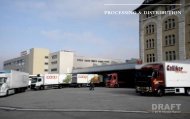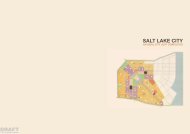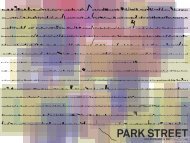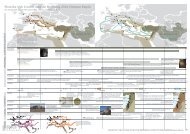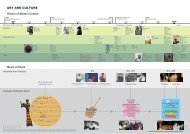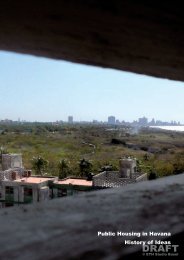BASEL-STADT: 4 PRoPoSALS - ETH Basel
BASEL-STADT: 4 PRoPoSALS - ETH Basel
BASEL-STADT: 4 PRoPoSALS - ETH Basel
Create successful ePaper yourself
Turn your PDF publications into a flip-book with our unique Google optimized e-Paper software.
The Inner City<br />
Leisure activities dominate the city centre. Housing has<br />
been reduced to very specific high standard sites. The city<br />
centre structures itself around the socialising factor and<br />
central attractions, illustrated by the range of shopping<br />
offers, gastronomy, cultural activities and possibilities,<br />
most of which “only“ take place in the city centre. Events<br />
spreading over the city centre and along the rhine, such as<br />
the “Floss“, “Chill am rhy“ or the “Fasnacht“ bring live and<br />
themes to public spaces. All activities and topics seem to be<br />
concentrating themselves along a distinct “path” through<br />
the city, connecting <strong>Basel</strong> SBB with Badischer Bahnhof: from<br />
the cultural site of Theater and Kunsthalle to Barfüsserplatz<br />
and Steinenvorstadt with a very high concentration around<br />
gastronomy and some shopping opportunities. Freie Strasse<br />
and Gerbergasse, the “main” shopping streets lead to<br />
the market square, where a small daily food market takes<br />
place. The market square seems empty, offering no spatial<br />
qualities for people to spend time and around the Markthof,<br />
Fischmarkt and Schifflände have been spatialy reduced<br />
to traffic and completely cut off from the historic urban<br />
structure around Spalenberg by the Spiegelhof-building. The<br />
Mittlere Rheinbrücke leads to Claragraben with Rheingasse<br />
and Klingental, where gastronomy grows very dense<br />
– Food in <strong>Basel</strong> II – – City Core: Central Market –<br />
Schneidergasse: “Hasenburg“, next to Imbergasse (originally named “Ingwergässlein“ because of spice trading) and<br />
Andreasplatz, a former market space. “Gifthüttli“ on the right was the first restaurant in <strong>Basel</strong> to serve both wine and beer.<br />
again, especially along the rhine. Restaurant “Lällekönig“<br />
at Schifflände has existed for over 200 years and today still<br />
sticks his tongue out to Kleinbasel, symbolising the historic<br />
significance of the site. After Claraplatz, Clarastrasse connects<br />
the exhibition square with Badischer Bahnhof.<br />
Basle always fed itself through it’s Hinterland: farmers came<br />
to the town centre to sell their produce. As a commercial city<br />
the element of travel was very important for it’s development.<br />
Schifflände establishes the situation where the topic of food<br />
and the city centre historicly come together: as a “deliveryspot<br />
and entrancepoint“. Food was brought to <strong>Basel</strong> over the<br />
Rhine and the Mittlere Brücke and from Schifflände it<br />
was distributed to all market spaces along the Birsig.<br />
The Birsig flowing through the inner city and finally in to the<br />
Rhine, just under the site of Schifflände was open until 1899<br />
and separated the historic city: todays Falknerstrasse didn’t<br />
exist as can be seen on the following plans. There has never<br />
really been food production within the historic city walls.<br />
Food was traditionally influenced by Germany and France<br />
(Markgräflerland, Baden, Sundgau, Elsass), which is also the<br />
reason why there is no real “<strong>Basel</strong> cuisine“.<br />
– 520 – – 521 –<br />
Unterer Rheinweg: “Mittlere Rheinbrücke“ and Schifflände seen from Kleinbasel<br />
DRAFT<br />
Market square: Market on a Tuesday<br />
© <strong>ETH</strong> Studio <strong>Basel</strong>



